New York Grown Oranges!
/21 Comments/in Design, Flowers, Fruit/by Lee ReichYes, A True Citrus
Oranges? In New York, planted outdoors in the ground? Yes, I have them ripening on the branches now. No matter if they ripen thoroughly or not because, although they are true oranges, delicious flavor is not one of their assets. It’s still a plant well worth growing.
The plant is the aptly named “hardy orange,” actually a true citrus species, Citrus trifoliata. (Previously, hardy orange was a citrus relative; botanists recently moved it to the Citrus genus from the closely related Poncirus genus.)
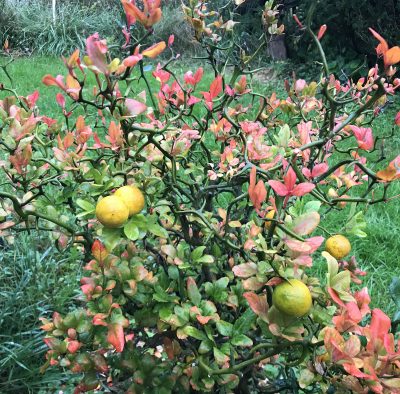
Mostly I planted hardy orange for its stems, whose show is at the same time intimidating, interesting, and decorative. Stems of the variety that I grow, Flying Dragon, twist and contort every which way, and then add to the show with large, recurving thorns. Stems and thorns are forest green, even as they age, and remain so all through winter to make the plant especially decorative when leafless.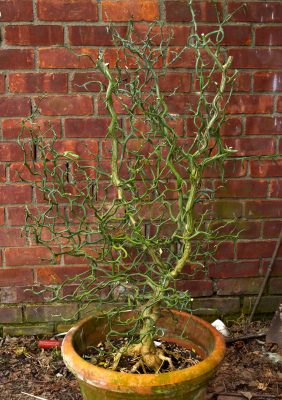
I would have planted Flying Dragon hardy orange just for its stems. But adding to the show, in spring are white flowers — citrus flowers — that are fragrant just like those of oranges and lemons. On my plant, at least, they’re smaller with commensurately less fragrance.
This year, this month, Flying Dragon has presented yet another attractive face. Its leaves are preparing to drop by turning a pinkish crimson. This color, developing for now on leaves towards the ends of the topmost branches contrasts nicely with the still forest green leaves and the few fruits starting to yellow.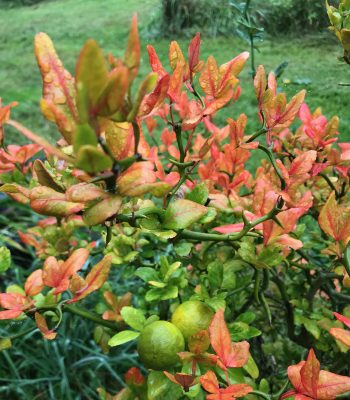
The problem with the fruits, gustatorily, is that they’re not very juicy, and they are very tart, somewhat bitter, and seedy. Still, they can be used to add a bit of home-grown citrus flavor to an -ade (Flying Dragonade?), fish, etc.
I Plant A Seed
New hardy orange plants are easy to raise from seed. The most important ingredient, as with other citrus, is not letting the seeds dry out once extracted from the fruit.
With most plants, you don’t get an exact replica of the mother plant in seedlings. Plant a McIntosh apple seed and the resulting tree will not bear McIntosh apples. (Just as you are not a genetic replica of your mother.) It depends on what pollinated the mother tree and how the chromosomes sorted out. Even though peaches are self-pollinating, the offspring of a Redhaven peach won’t bear Redhaven peaches.
Plant a seed of Flying Dragon hardy orange (or some other citrus varieties, in general), and you could get more Flying Dragons, exact replicas of the mother plant. That’s because citrus are among the few plants that exhibit apomixis, that is, seeds within the fruits that develop from only mother plant tissue.
Other plants that also bear apomictic seeds are some species of onion and dandelion. Some coneflowers, apples, and raspberries also bear apomictic seeds, but only if the flowers are pollinated — even though the pollen does not insinuate itself into the apomictic seed’s genetics.
Not all the seeds within a Flying Dragon fruit are apomictic. Hence, not all will grow to become Flying Dragons.
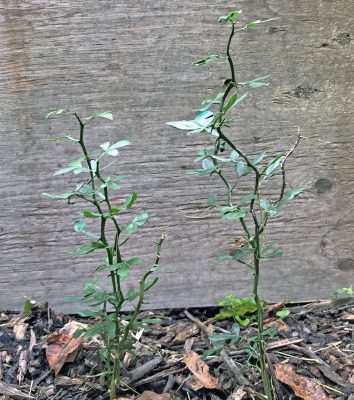
The seedling on right is probably apomictic
Further complicating matters, some seeds can develop into more than one seedling! And some of those seedlings growing from that one seed might be apomictic while others will be run-of-the-mill.
None of these complications interferes with my propagating Flying Dragons from seed. The contorted stems and recurved thorns are so distinctive that it’s easy to tell the Flying Dragons from the others. Apomictic seedlings also are generally more vigorous than sexually-produced seedlings.
Not Everyone’s A Fan
Southerners are not nearly as enamored with hardy orange as I am . The hardiness, the thorns, and the seeds’ enthusiasm to sprout make the plants a threat down there, where the shrubs grow from 8 to 15 feet tall.
Hardy oranges were introduced into the south about 150 years ago, possibly to contain livestock. There, the plants have spread to woodlands, forest edges, and fencerows to shade out native plants. The lack of affection for the plant might be summed up in a quote from a Texas publication stating that hardy orange “does respond well to bulldozing.”
While bemoaning not being able to grow southern magnolia, gardenia, camellia, and crape myrtle this far north, I am thankful for being able to grow hardy orange without any danger.
Happy “Nose Twist,” Sad Tomatoes
/15 Comments/in Flowers, Vegetables/by Lee ReichNasturtium In Its Element
It’s nice to see that at least someone or thing enjoys the current cool, wet weather. My eight ducks, for instance. As I open the door to “duckingham palace,” each duck pads out onto the slurpy ground as happy as a lark (a lark on a sunny day, I assume). 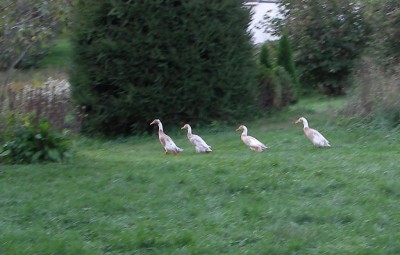 Also enjoying this awful weather are the oat cover crops that I’ve sown in some of my vegetable beds. The oats are especially lush and green, as is your and my lawn grass. The same goes for beds I recently planted with lettuce, radishes, arugula, turnips and other cool weather vegetables.
Also enjoying this awful weather are the oat cover crops that I’ve sown in some of my vegetable beds. The oats are especially lush and green, as is your and my lawn grass. The same goes for beds I recently planted with lettuce, radishes, arugula, turnips and other cool weather vegetables.
Nasturtium flowers, which I planted back in May, went hardly noticed all season long. But now they are lush, their red flowers boldly staring out against the background of their round disks of bluish green leaves.
The plants’ present prominence comes, first, from the weather. Native from the cool highlands of Mexico down into Chile and Argentina, the plants feel right at home, and show it with their luxuriant growth, when I’m beginning to feel chilly. They also have come into prominence because some of their neighboring plants — marigolds, cucumbers, and tomatoes, for example — are waning.
Nasturtium offers a lot of bang for the buck, so for many years, each May, I’ve dropped the seeds into holes I poke into the ground. Mostly I plant them near my garden gates but also, some years, along the wide, main path at the head of each of the vegetable beds. The latter planting was an emulation of painter Claude Monet’s well-known nasturtium plantings that softened the wide path beneath his long arbor. The plant isn’t really a climber, but may be called a clamberer; that’s how it makes its way partway up nearby gates and wire fences.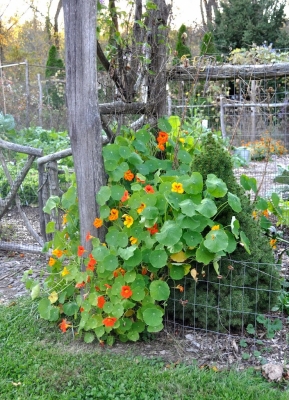
Nasturtium seeds germinate readily once the soil warms sufficiently and then are care-free all summer long. The large size of the seeds and their quick germination make them fun for children to plant and watch.
Sometimes the plants are so care-free as to need some discipline. The ones I planted along my path required pruning to keep them from meeting in the middle and obliterating the path.
Nasturtium offers more than just beauty. All parts of the plant are edible. The leaves add a pungent pizazz to a sandwich, the flowers add pizazz and eye appeal to a salad. The immature seeds can be pickled as stand-ins for capers. One nasturtium species, called mashua in some parts of the world, is a perennial producing edible tubers. This one is an actual climber rather than a clamberer.
And Now, for Nose Twist
Nasturtium got its common name because of its similarity in taste to watercress, which is botanically Nasturtium officiale. The word “nasturtium” comes from the Latin words nasus, meaning “nose,” and torqueum, meaning “twist,” which is what the peppery flavor of watercress or nasturtium does.
Despite one plant sharing its common name with the botanical name of the other, nasturtium and watercress are not in the same family. They do, however, share certain flavor profiles (which is why both are nose twisters). So much so that the cabbage white butterfly will feed on nasturtium as well as its namesake, cabbage. But not with great enthusiasm. The caterpillar phase of the cabbage white butterfly will only feed on nasturtium if it did so from birth; try feeding it to the second or third instar of this insect, and it would rather starve, literally!
The genus for nasturtium is Tropaeolum, the “trop” part related to the word “trophy.” Founder of plant taxonomy, Carl von Linnaeus, assigned this name because the clambering flowers and leaves reminded him of the helmets and shields of the vanquished which were draped on tree branches following battles in his day.
Tomatoes Exit
In contrast to the nasturtiums, my tomato plants are not at all happy with the weather now — or for much of this summer. Humid conditions have fostered diseases, the usual leaf spotting diseases (early blight, late blight, and septoria leaf spot) as well as anthracnose.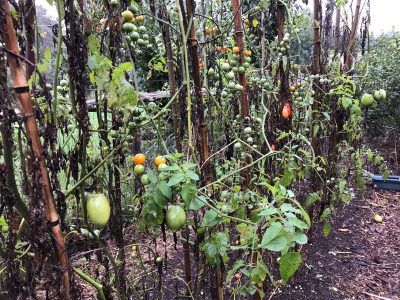
Anthracnose is particularly vexing because apparently sound tomatoes develop the sunken, rotting lesions from this disease after only a day or so on the kitchen counter.
A thorough cleanup of all tomato leaves, stems, and fruits, covering the ground with compost, and moving tomato plantings to new locations should help limit disease next year. Also, wearing red shoes and clicking my heals together three times before planting might help.
The passing of tomatoes isn’t all that bad because they don’t taste that good in this weather. And we do have a reasonable amount broadcasting their richness through the sparkling clear glass of canning jars.
Wild and Cultivated Pleasures
/7 Comments/in Design, Flowers, Fruit/by Lee ReichMythbusting
Before going any further, let me bust a myth that still might be having some traction: Late summer and fall allergies are not caused by goldenrod (Solidago spp.). 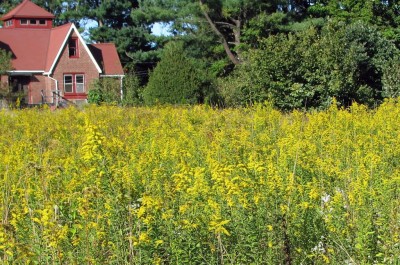 Goldenrod gets the blame for its showy, yellow blossoms during this allergy season. But the true culprit is ragweed, which goes unnoticed because it bears only small, green flowers.
Goldenrod gets the blame for its showy, yellow blossoms during this allergy season. But the true culprit is ragweed, which goes unnoticed because it bears only small, green flowers.
It makes sense that the pollen of a showy flower would not cause allergies. Showy flowers put on their show to attract insect (and, in some cases, bird or bat) pollinators. Wind can’t carry their heavy, sometimes sticky, pollen.
Pollen that causes allergies wafts around in the wind. Wind-pollinated flowers (euphoniously called “anemophilous” flowers) don’t need to attract animal pollinators.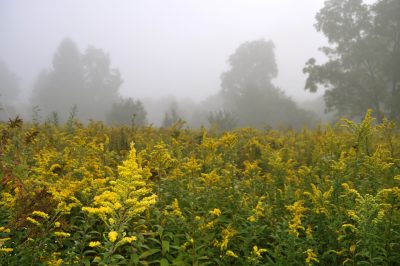
And Now, Enjoy the Flowers
With that said, I can safely revel in the rich golden yellow with which goldenrod’s flowers are painting sunny hillsides and fields this year. Goldenrod’s beauty comes as no surprise once you realize that it comes from a very good family, the Daisy Family, Asteraceae. Sunflower, black-eyed-Susan, coneflower — and thistles and dandelion — are among its kin.
Confirm goldenrod’s heritage with a magnifier trained on one of its small florets. Flowers in the Daisy Family are made up of one or both of two kinds of florets. Each disk floret is a relatively small, symmetrical tube of fused petals. Petals of the other kind of floret, ray floret, are also fused, but asymmetrically into one long, strap-shaped petal. The head of a sunflower (most varieties) is mostly disc florets circumscribed by prominently-petaled ray florets that create that decorative ring around the head. At the other extreme is a dandelion flower, all of whose florets are ray flowers, resulting in a powderpuff of yellow petals. Most species of goldenrod have flowers like those of sunflower — but you have to look closely. (For more about plant families, see my new book The Ever Curious Gardener: Using a Little Natural Science for a Lot Better Garden.)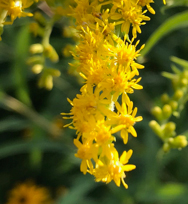
Meadow Reclamation
My meadow — or hayfield, or whatever you want to call it — was once replete with goldenrod. And before that, pale lilac flowers of wild bergamot (Monarda fistulas) blanketed much of the field. And before that, the field was grass, kept that way by the previous landowner’s regular mowing throughout the season.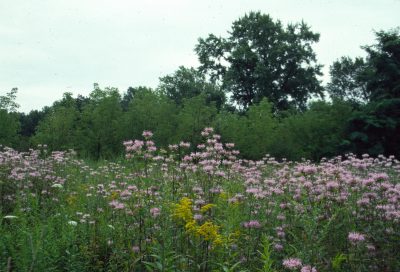
Sadly, for me, goldenrod has lost its prominence in my field, replaced by coarser and more woody plants such as poison ivy, sumac, and wild blackberries. My once-a-year mowing has kept these plants from totally getting control of the landscape. Without mowing, the field would, in time, become forest.
This spring, I decided to try to reclaim the field and, I hope, invite back some goldenrod and wild bergamot. My modus operandi is to mow regularly. In previous years, the wide paths I would mow and maintain mowed through one season would reflect that mowing for at least the following season or two or three. Mostly, it was the grasses, the only plants that can tolerate frequent mowing, that came into prominence.
I expect plants such as goldenrods and wild bergamot will gain footholds beginning next year and increasingly so in years to follow — until, of course, poison ivy and friends start to move in again.
Landscapes aren’t static, and changes come relatively quickly, not always predictably as the changes are seasoned with each year’s and more long term weather and climate patterns.
Wild Aromas, Cultivated Flavors
Wild grapes are also prominent in the wild landscape this year, mostly from the jasmine-like aroma with which they perfume the air. Here in eastern U.S. and Canada, fox grape (Vitis labrusca) is a prominent wild grape.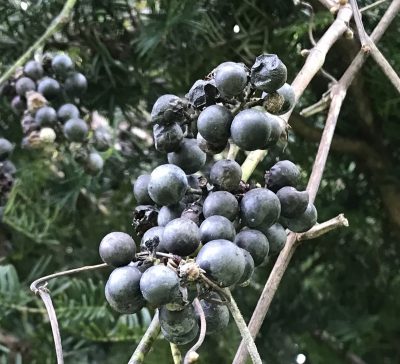
The variety Concord typifies the flavor and texture of fox grapes. Why “fox?” No one knows for sure, but around 1880, the botanist William Bartram suggested that the epithet was applied to this grape because of the “strong, rancid smell of its ripe fruit, very like the effluvia from the body of a fox.” Others suggested the epithet came about because foxes ate the grapes, or because the leaves resembled fox tracks.
Disease resistance and cold tolerance of fox grapes helped save the French wine industry a century and a half ago, when these grapes were hybridized with the traditional, disease-prone wine grapes (V. vinifera) of Europe. Thousands of hybrids now exist all along the spectrum from vinifera to fox as far as flavor, disease resistance, cold tolerance, and other characteristics.
I’m enjoying the aroma of the wild grapes but most appreciate the flavors of Vanessa, Somerset Seedless, Alden, Edelweiss, and my other cultivated varieties.
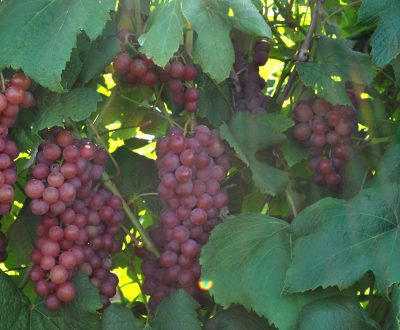
Vanessa grapes

